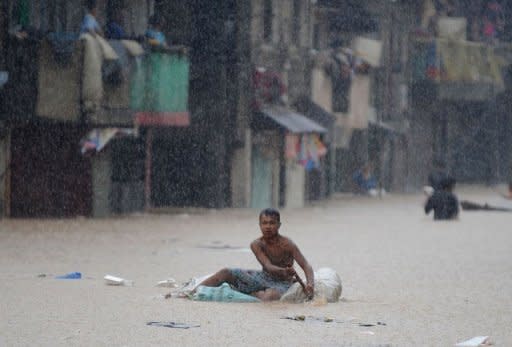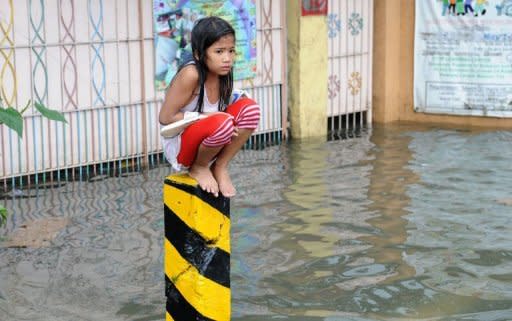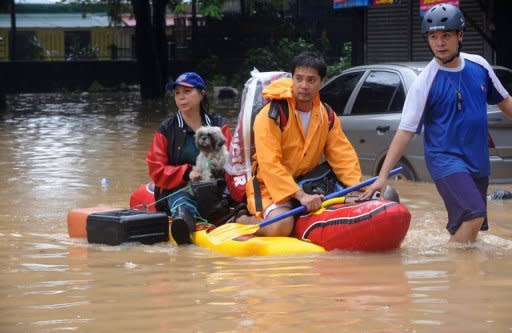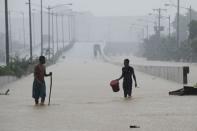Appeal to help two million Philippine flood victims
Philippine authorities appealed Thursday for help in getting relief to two million people affected by deadly floods in and around the capital, warning that evacuation centres were overwhelmed. After more than a month's worth of rain was dumped on Manila in 48 hours, entire districts remained submerged although overflowing rivers had started to recede and neck-high waters seen earlier were typically down to knee deep. The state weather service also dropped its rain warning on Thursday for the sprawling city of 15 million people, and a rare bout of sunshine in the afternoon added to an exhausted sense of relief for many. Disaster chiefs said the top priority was to help the 2.1 million people affected by the floods, as masses flocked to evacuation centres in search of a dry place to sleep, food, water, medicine and clothes. "We are repacking a lot of relief items, we need more help and are asking for more volunteers," Social Welfare Secretary Corazon Soliman told AFP. "We have the food but we need to pack them, deliver and distribute them in this massive operation." Soliman said many evacuation centres were not able to provide much-needed warm meals to the growing number of displaced. "Most local government units do a community kitchen, but the volume of evacuees is so big that they have been overwhelmed. We are also appealing for more medicines, blankets, mats and, more importantly, dry clothes," she said. The number of people in schools, gymnasiums and other buildings that had been turned into evacuation centres rose to 315,000 on Thursday, from 150,000 on Wednesday, according to the government's disaster management council. Meanwhile, hundreds of thousands of others were left largely to fend for themselves, seeking refuge with friends and relatives, or staying in partly submerged homes. In the riverside district of Marikina, where massive squatter communities were inundated, some residents returned to their homes on Wednesday night only for another deluge to hit a few hours later and cause another flood spike. "Last night many came back, but when the alarm rang at 3:00 am they had to evacuate again," said Colonel Perfecto Penaredondo, chief military aide at the civil defence office. One of those forced to evacuate once more, housewife Alona Geronimo, told AFP she and her neighbours were exhausted and feeling hopeless. "We were cleaning our house yesterday when the water rose again. No one has caught a wink of sleep here. If we fall asleep, we might die," Geronimo said as she huddled with 13 other people under a grey tarpaulin. Geronimo said she had not been able to save anything in the floods. "We have just the clothes on our backs. It was just like Ondoy," she said, referring to a tropical storm in 2009 known as Ketsana in English that submerged 80 percent of Manila and killed 464 people. Twenty people have died from this week's rains in Manila and nearby provinces, according to authorities. Officials in provinces surrounding Manila reported on Thursday that at least 10 more people had died, however the national disaster council responsible for the official toll said these had not yet been confirmed. The deluge came after nearly two weeks of monsoon rains, compounded by a typhoon and tropical storm, that have left 73 people dead across the Philippines. The Southeast Asian archipelago endures about 20 major storms or typhoons each rainy season, many of which are deadly. But this week's rains were the worst to hit Manila since Ketsana. Environment Secretary Ramon Paje warned that the Philippines must prepare for more intense rains caused by climate change, describing this week's deluge as the "new normal". But he and other politicians also emphasised that the extent of the current crisis and the fatalities were man-made, with people being allowed to live in danger-zones and watershed areas being damaged. Millions of slum dwellers live along rivers such as in Marikina, the swampy surrounds of a huge lake, canals and other areas susceptible to flooding. Meanwhile, vast amounts of garbage are dumped by a fast-growing population and clog drainage systems.











